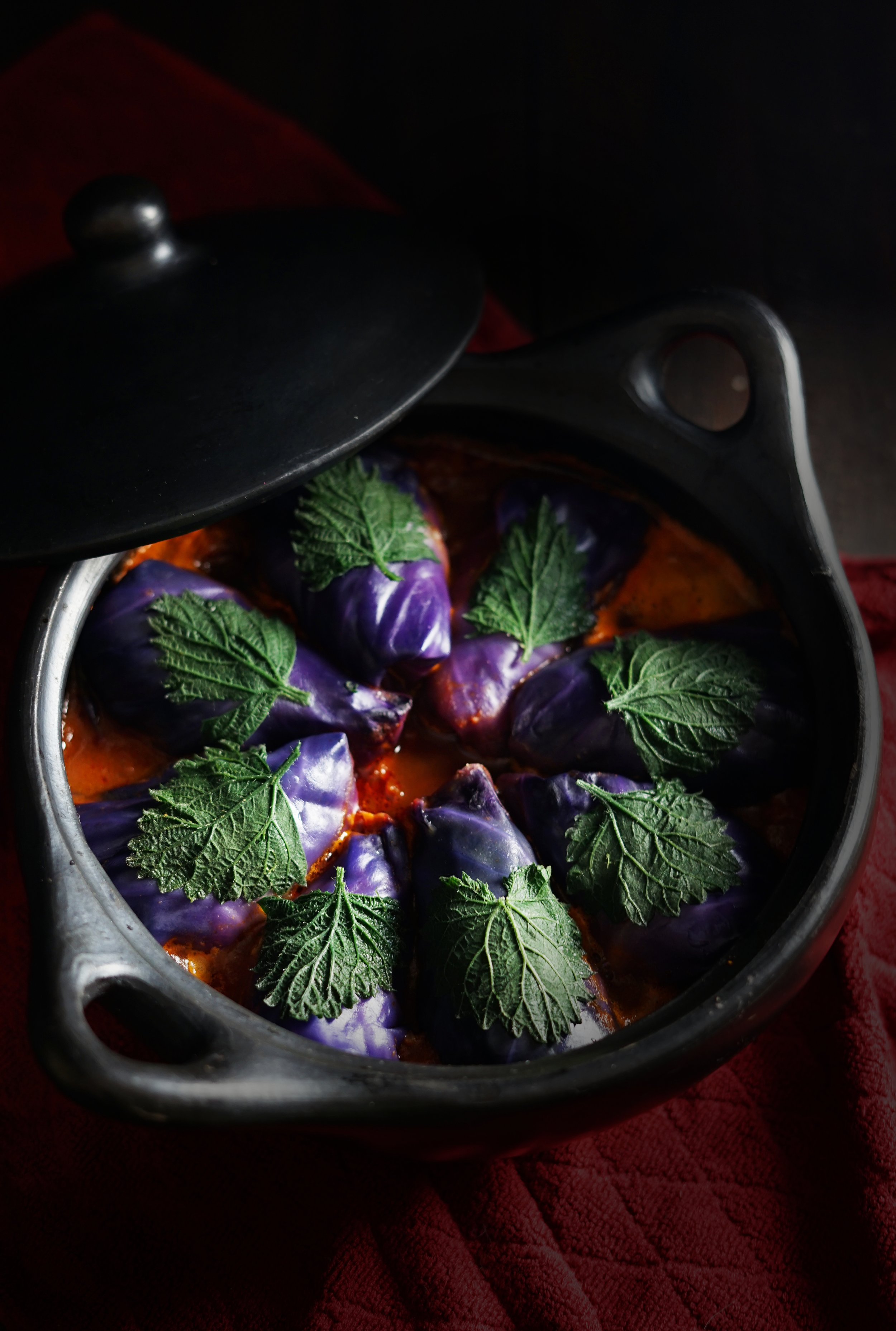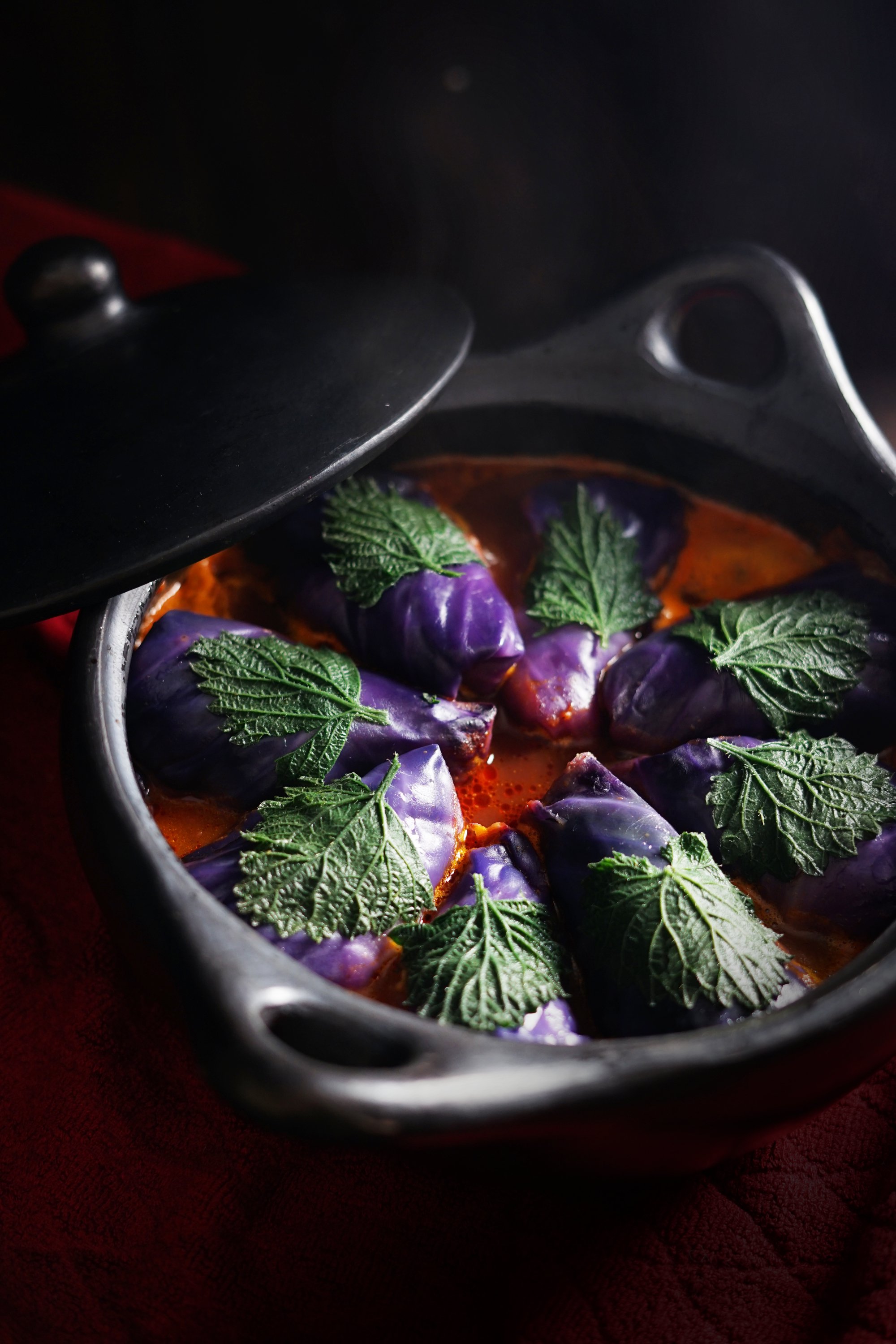Edible Heirlooms and Wild Greens Cabbage Rolls
New to foraging? Learn more about ethical and safe foraging (plus how to get started) here!
I have long held a fascination with heirlooms. Listening to my grandmother tell me the stories that accompanied the treasures in her home filled me with a sense of connectedness, a romantic glimpse into where I came from. And while I hold those ancient objects in reverence, I am less focused on material artifacts now. I start wondering what my Great Great Great Grandmother’s favorite meal was, or if my Grandmother’s lemon chicken recipe was handed down or invented by her. The violets that bloom in my garden every year were transplanted from my mother’s, who received some as a gift at the historic estate of my notorious ancestor Helena Modjeska. I like to believe that they accompanied Modjeska across oceans to the New World, a little sight of Poland in her new home in Orange County, California. The yellow rose in my mother’s garden is an heirloom too, as are the few faded recipe cards we have in our foremothers’ handwriting. I think of my ancestors as I cook or bake, especially when the familiar scents of dill or caraway float up from the pan. Perhaps they, too, made the same meal for someone they loved.
While I feel at home in the wilds of the Pacific Northwest, I know that my roots have stretched and stretched over time and over distance. Many of those threads are tied to Eastern Europe, particularly Poland, and with it a cuisine that is is strongly based in a tradition of foraging. Surviving through oppressive times or horrific scarcity, the people of this country took to the woods and fields, filling their larders with pickled mushrooms or dried fish. My mom recounts my grandmother hunting for the right variety of lactarius mushrooms for salt-pickling. Perhaps that hunger for a connection to my landscape is coded into my very being too. Foraging was a way of life and a source of resilience to my ancestors. Poland’s history is full of outside forces taking over the country. How could a culture stay steady through such a long history of war and oppression? By holding on to their traditions, adapting new foods to fit their taste and resources, and turning to the woods to fill out their diets. As Zuzu Zak says in her book Polska: New Polish Cooking:
“We can taste the Middle East in the famous golambki -- cabbage leaves stuffed with rice and meat as well as the refreshing cucumber and yoghurt salad we eat during the summer. Bread and butter, soured milk, pickles, radishes, cumin, paprika and dill are popular in our culture, yet working out where these culinary influences came from is a bit like looking for a needle in a haystack. I suspect many popular Polish dishes originated in the homes of Armenian and Jewish immigrants and were adapted to include Polish ingredients and cooking methods. Cooking, like all oral traditions, was passed down from one family member or friend to another, as an everyday act of love and as a means of keeping these culinary heirlooms alive in the memories of each generation. And so, before literacy became widespread in Poland, these recipes only existed in the nation’s memory.”
I love that there are recipes I know only by feel, ones that never got jotted down but my mother taught me, the way hers taught her. I love that I can adapt a traditional recipe to fit my own landscape in the same way that my ancestors adapted foreign foods into ones that are now clearly recognized as Polish. I love that the culture and flavor of history can be experienced first-hand, rather than only living on the pages of a book.
This recipe is for my foremothers, adapted to my life here in the Pacific Northwest. I’ve stuffed mine with early spring nettles and wild onions, plus some dried currants from last fall for a burst of flavor. Those hearty greens enliven the meat filling and add a lot of nutrition to the dish as well. I think they would be proud of my resourcefulness.
Do you have a favorite family recipe that could be adapted with foraged or local ingredients? Perhaps you could try replacing the almond flour in your family’s torte recipe with acorn flour, or use rose petal jam in your donuts instead of blueberry jelly. To me, this practice of combining my landscape with my heritage marries them together in a way that is deeply satisfying. Perhaps you’d feel the same way too. In any case, these purple cabbage rolls are worth trying no matter what your background is. These lovely rolls are delicious and filled with a juicy, flavorful filling. They’re a wonderful source of connection and energy on a late winter’s eve.
Wild Greens Purple Cabbage Roll Recipe:
Makes 12 rolls (I used two pans since my pan only fit eight, as shown.)
Sauce:
2 Tbs. vegetable oil
1 small onion, finely diced
1 Tbs. tomato paste
1 tsp. Sugar
1 tsp. Salt
½ tsp. Chili powder
1 fresh bay leaf
14.5oz can chopped tomatoes.
1 ½ c. water
Salt and pepper, to taste
Filling:
1 large red cabbage
½ lb. ground beef
¼ lb. ground pork
¾ c. white long-grain rice
½ c. dried wild currants
Pinch cinnamon
3 c. nettle leaves
2 Tbs. chopped wild garlic or wild onion
2 tsp. Salt
1 tsp. Smoked paprika, optional
Directions:
Start a large pot of boiling water on the stove over high heat. Meanwhile, heat the vegetable oil in a flame-proof casserole or baking dish. Add the onion and cook until soft and translucent. Add the sugar, salt, tomato paste, chili powder, and bay leaf and stir well, then add the can of tomatoes and water. Season with salt and pepper and let the sauce simmer on low heat while you prepare the cabbage rolls. Check it every few minutes and add more water if it boils down too much.
First, you’ll need to blanch the nettle leaves, cabbage, and parboil the rice. I prefer to blanch the nettles first so that any nutrition in the water can be re-absorbed. To blanch the nettle leaves, boil them for 2 minutes, then scoop them out with a slotted spoon and place in ice water to cool, then pull them out with a colander. Next, boil the whole cabbage for 15-20 minutes, then cool in a pot of cold water. Very gently peel off 12 large leaves, avoiding tears. Pat to dry. You may need to boil the head of cabbage for longer after you’ve removed a few layers of leaves. Set the boiled whole cabbage leaves aside to fully cool. Add the rice to the water and boil for 5 minutes, then drain.
Prepare the cabbage leaves for rolling by cutting a “V” into the base end to remove the thickest part of the stem.
To make the filling, set aside 12 of the prettiest nettle leaves, then finely chop the rest and squeeze out any water in a paper towel. Finely chop the wild onions or ramps as well. Add the ground meats, rice, dried currants, cinnamon, paprika, and some pepper. Mix well, making sure everything is evenly incorporated. Divide the filling up into 12 portions and wrap each portion in a cabbage leaf. (If you’ve ever made a burrito, it’s a similar process. Place the filling in the middle of the leaf, then fold the side edges over to cover. Keeping them folded over the filling, roll the leaf up around the filling starting with the thicker end.) Place a reserved nettle leaf on top of each.
Place the parcels on top of the sauce, folded side down. They should be packed in tightly to keep from unrolling. Cook over low heat for 45-60 minutes, or until the meat is fully cooked and the rice is soft. Serve hot with sauce.
Love what you’ve read here? Don’t forget to Subscribe to get frequent updates of new posts!
Huge thanks to my Patrons that make sharing all of these lovely posts with you possible (without all of the pop-ups and ads that make browsing other blogs so annoying). If you’re feeling generous, you too can support the wonder with a monthly contribution of your choice. Even $1 helps a lot! Your donation will help to fund this blog as well as my surprise free events and gifts for strangers. Learn more about this program at the link below:


















Join me for a little winter night magic as we bake this cake full of rich seasonal flavors and black cocoa!